The Surveyors:




Survey Questions with Rationales and Data
Question #1 Rationale
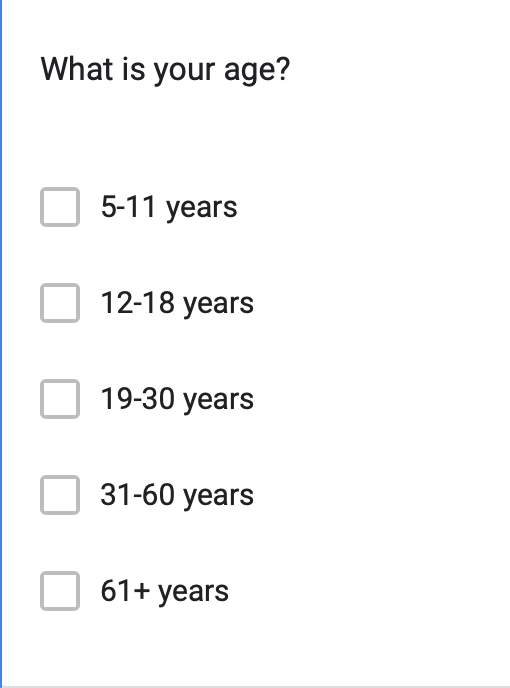
We felt it was important to determine the age groups to identify patterns and understand which strategies were most effective for each specific group. By categorizing the ages into elementary, middle school, post-secondary, adult, and older adult groups, we aimed to gain insights into the unique learning needs and preferences.
Data
Sample size: 22 people
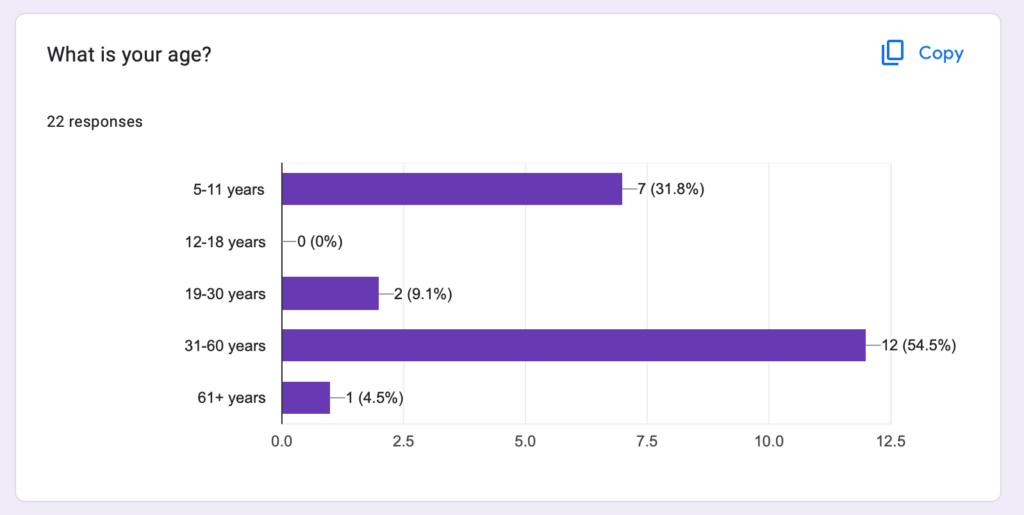
Most survey responses were received from people ages 31-60 years old that we previously knew or in our community. Jennie also went into Steeples and was able to interview 7 students ranging from 5-11.

Pattern: The data shows that ages 5-11, the preferred strategy for learning English was watching videos.

Pattern: The data shows that ages 31-60, the preferred strategy for learning English was interacting with others in conversation.
Question #2 Rationale

We wanted to identify their first language to better understand their cultural background and determine if it influences their preferences for support in learning English. We wanted to see how diverse our survey would be.
Data
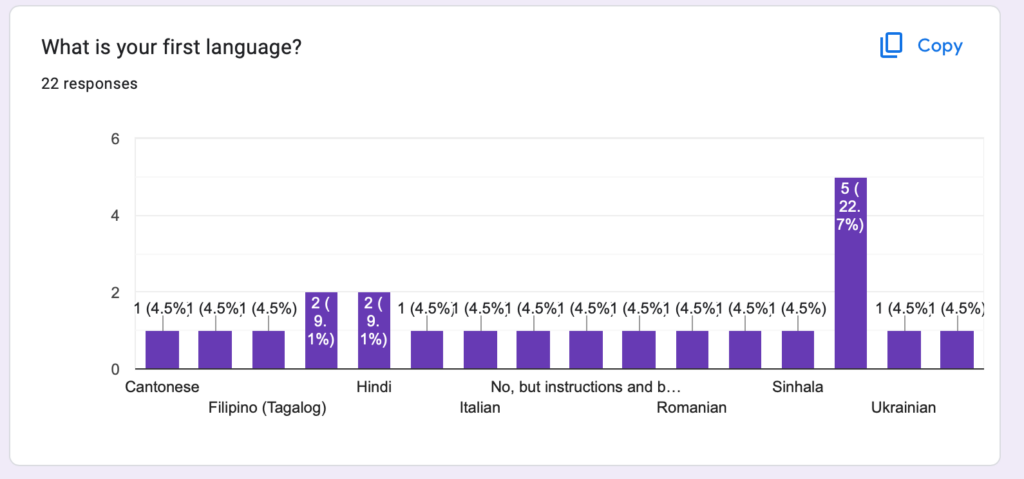
The most frequently spoken language in our survey was Spanish, represented by 5 individuals. Following closely were Hindi and French, each spoken by 2 participants. Interestingly, all other languages accounted for 4.5% each, with just 1 person per language (Malayalam, Italian, Cantonese, Filipino- Tagalog, Russian, Ukrainian, Urdu, Punjabi, Czech, Romanian, Hungarian/Serbian, Sinhala). After reviewing the data from our survey we discovered there was no connection between our surveyors first language and their preferred learning strategies.
Question #3 Rationale
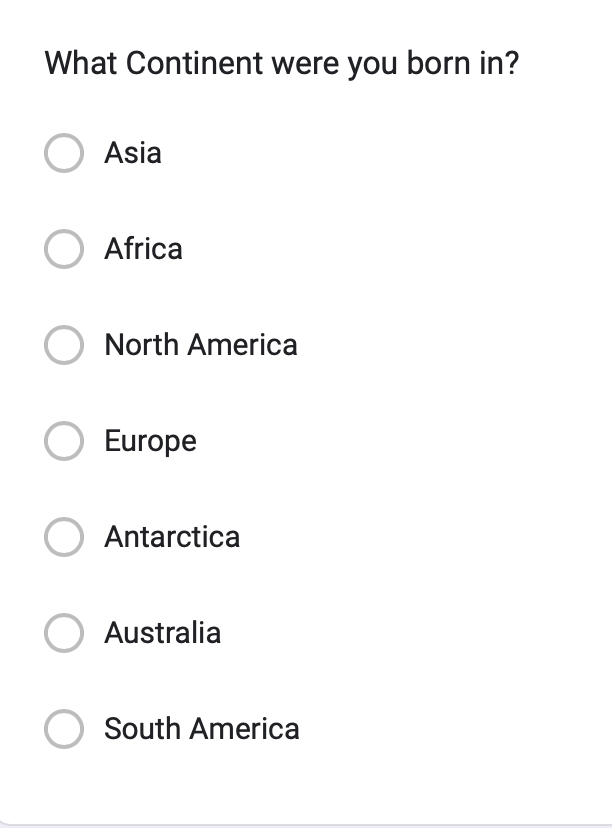
We aimed to learn about the diversity of language learners within our community to ensure that we are culturally responsive teachers. We had difficulty coming up with this question as we did not want to make any assumptions.
Data
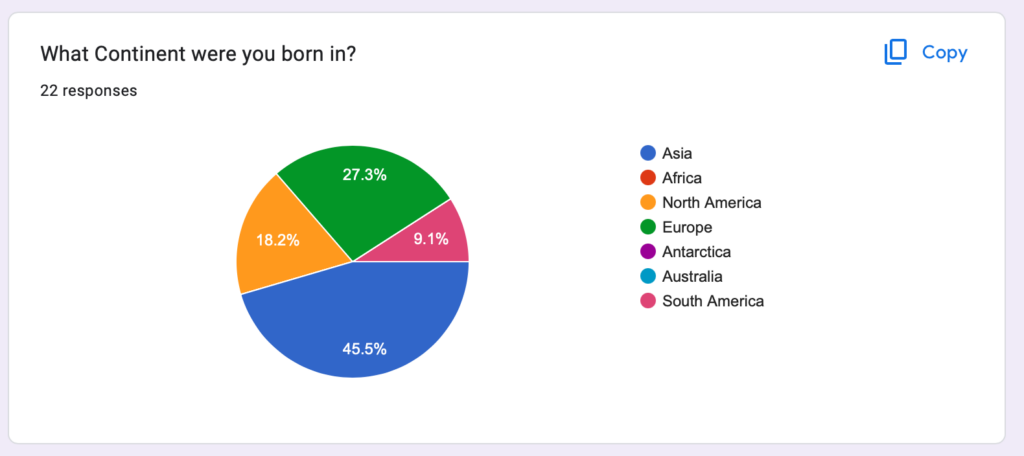
Asia had the highest percentage of participants, comprising 45.5% of the total, while South America represented the smallest share at 9.1%. Note: We recognized nobody participated from Africa, Australia, and Antarctica.
Question #4 Rationale
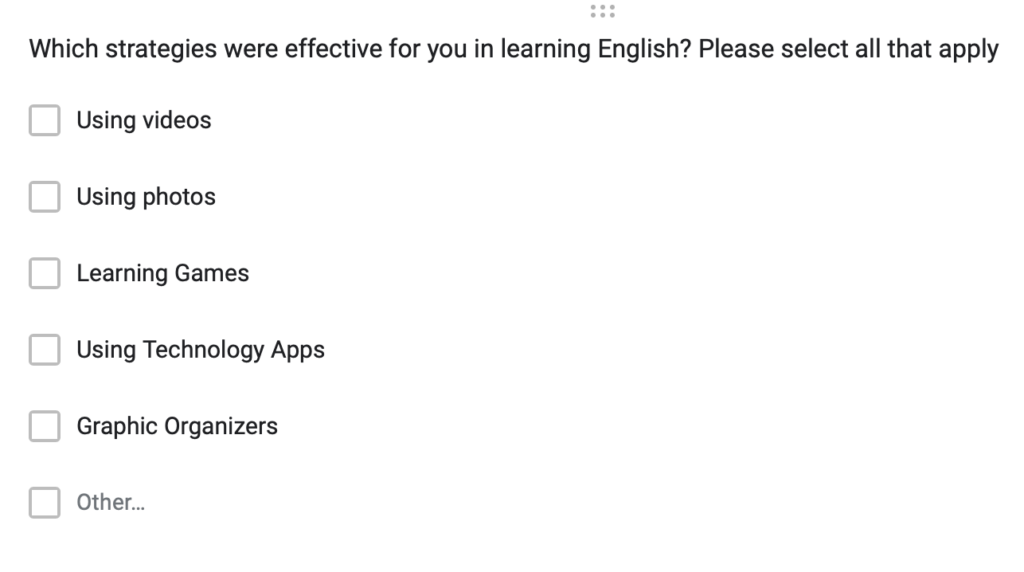
We wanted to evaluate some strategies we were all curious about and identify which strategies were effective and which were not, so that, as teachers, we could identify the most useful ones. We also included an option for “other” responses to capture any additional strategies we might not have been aware of, ensuring we consider a multitude of approaches that could benefit any of our future students.
Data
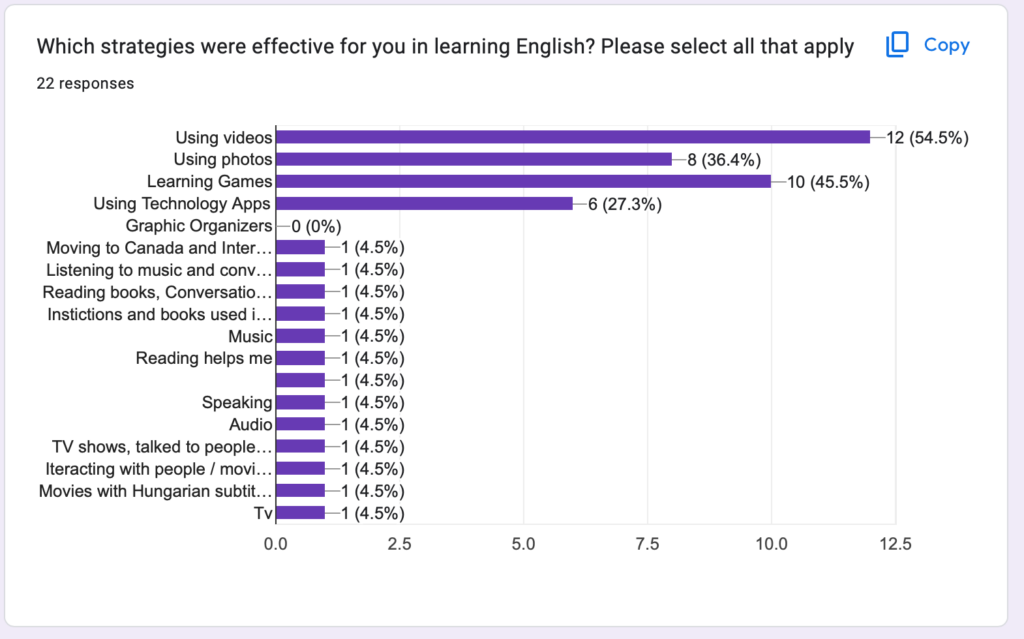
For this question, we selected the first five strategies: videos, photos, learning games, technology apps, and graphic organizers. Thankfully, we also included an option for other responses, which revealed a variety of additional helpful strategies. It’s clear that different approaches resonate with different learners.
Question #5 Rationale

As future teachers, we recognize that we can’t do it all on our own. That is why understanding who supports ELL students within the school, outside the school, and in the community is crucial for the well-being and motivation of the child.
Data

Here are a list of the most influential people for our surveyors in learning English:
- Friends
- Parents
- Children
- Siblings
- Kids programs at a Public Library
- Teacher
- Employer
- Spouses
- Grandparents
- Neighbours
- Artists (Music)
- Coworkers
Question #6 Rationale

We asked this question because we wanted to identify the most effective strategies. We chose to leave it as an open comment box to avoid influencing their responses, and the results revealed a wide variety of strategies that we might not have discovered without their input.
Data
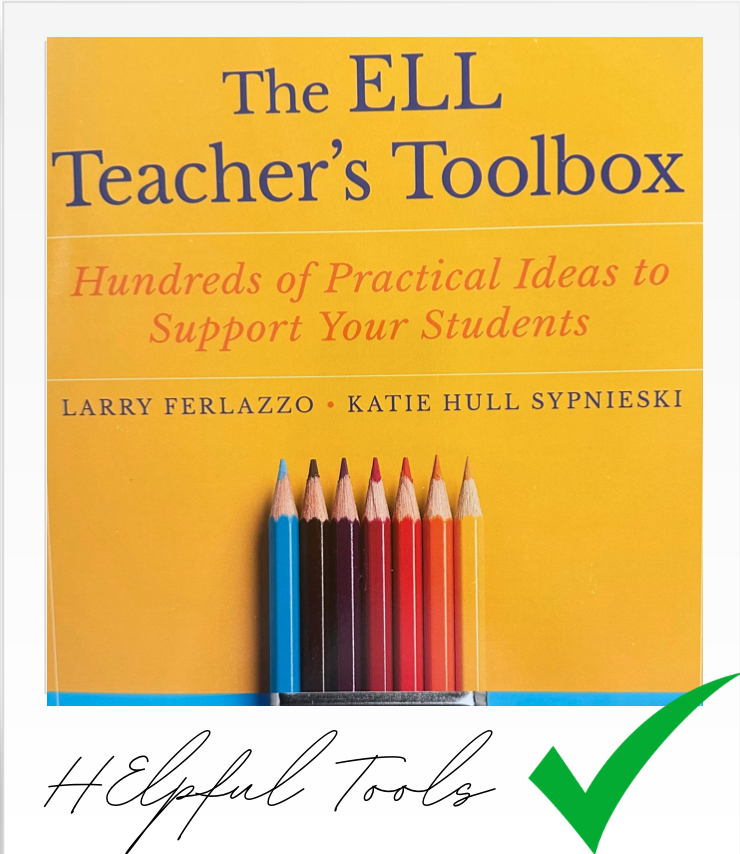
These are the actual responses provided by the people surveyed:
- Reading
- Visuals and Conversations
- Listening people talk
- Listening to TV
- Repeating words in tv shows ( renovation shows )
- Translating song’s lyrics
- Just lots of exposure
- Removing the opportunity to speak my first language, but have tons of shared culture background and interests. I wanted to hang out with these people, I had to speak the language.
- My favourite TV shows with subtitles.
- Practicing all the areas: speaking, reading, writing and listening. The more the better.
- It’s hard to say, speaking, reading and writing English has always been a big part of my Filipino education.
- Quite a bit from TV ,husband, sitting and explaining things and talking always English and reading books, watching tv, using dictionary. I didn’t have any actual English language courses at all.
- I would say watching english videos or reading books, taking down meaning of unknown words and learning them, communicating with an english speaker
- I have been taking classes since I am a little kid. What help the most is being around of people wanting to learn too. Watching movies and having conversations helped me a lot in and out of classes.
- Having conversations with friends and family is the best tool, also reading.
- Reading comics, Dr. Seuss and Grade 1 and 2 characters books.
- Finding a topic of interest that motivated me : music/lyrics was one of them. Moving to Lake Louise. Being engage in learning the language. having role models (english teacher in College).
- Interaction with others
- Growing up listening to songs in English ( not necessarily childrens songs but pop, rock etc).
- Movies were explicitly subtiteled so we were exposed to a lot of English but reading subtitles along.
- Lots of speaking encouragement and opportunities. In honesty though the biggest help was being in an environment with only English speakers.
- Speaking all day with Canadians.
- Apps
- Videos
- Audio: if you want to learn something you have to hear it first also video: YouTube and repeating
- Always video-English video, short 2 mins
- Using apps
- Videos- in spanish and English. Also games like board games.
Question #7 Rationale

We wanted to identify any patterns in strategies that may be ineffective so we can potentially avoid them in our future teaching, while still recognizing that every individual learns differently and ensuring a variety of strategies are available.
Data
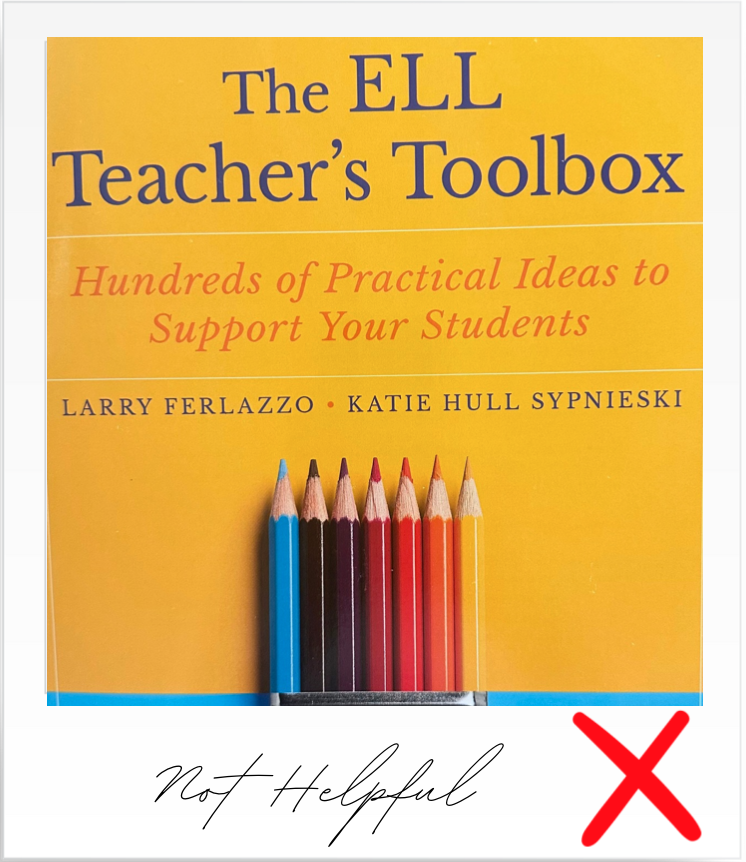
These are the actual responses provided by the people surveyed:
- Watching movies.
- Reading books – not knowing how to pronounce words.
- Studying the dictionary – seriously, who thought that was a good idea??
- Being around a lot of people at times was confusing as too many were talking and hard for me to absorb at times one on one was the best.
- Not practising (at home I use my first language as all my family and friends back home use my first language, I find if I use my first language a lot and not practising enough english didnt help)
- Learning the grammatical rules just by reading them. Too boring.
- Reading from a textbook, alone.
- Videos.
- I don’t think there is anything specially that was not helpful. We all learn differently so this would be a trial and error. Loved to do grammar but most of my peers didn’t.
- Graphic organizers, sometimes teachers didn’t help.
- Sometimes-boring things doesn’t help.
- Using TV wouldn’t help me because I don’t like watching tv.
- If a teacher didn’t show pictures that was not helpful.
Question #8 Rationale
We wanted to know for ourselves, and our classmate’s what advice ELL students would give to future teachers to help them in their journey to learn English.
Data
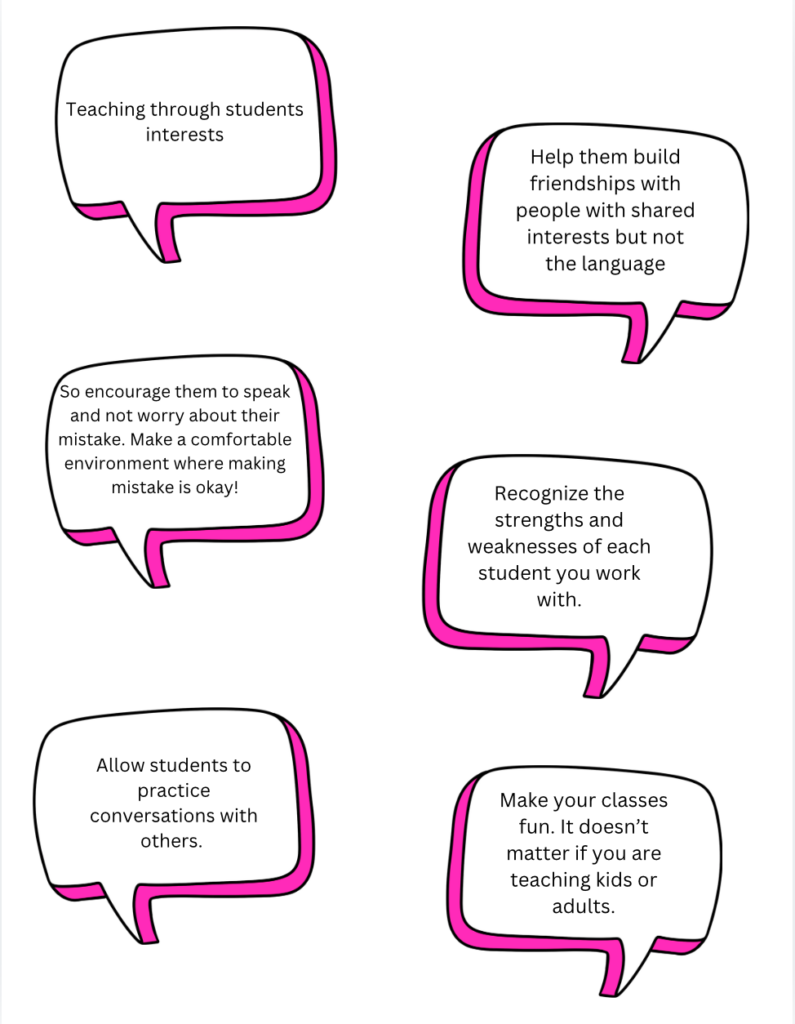
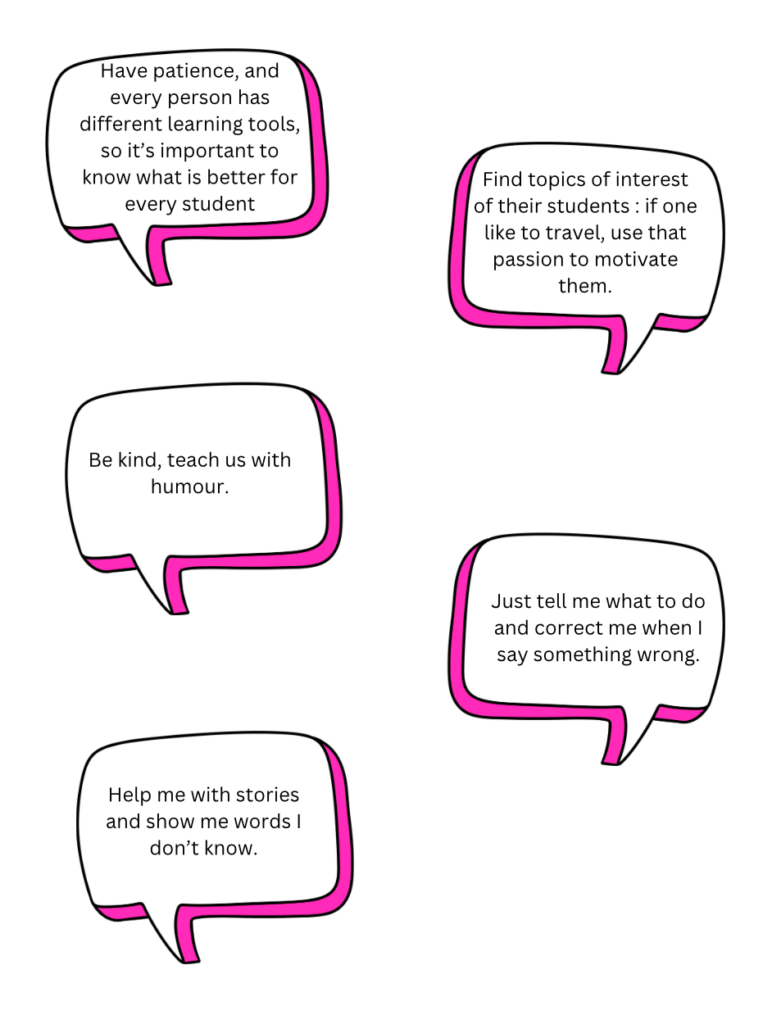
These are the top 11 responses we received from our 22 participants. Responses are copied from survey.
Summary/Takeaways

Map at Steeples Elementary School
The inclusion team at Steeples shared this map, which is located at the entrance of the building. Students pin where they are from, and on the side of the map, they are invited to share their country name and first language. The inclusion team also shared that the map creates a “sense of community and belonging for students while promoting cultural awareness.”
Culturally Responsive Teaching (CRT) – Note to be aware of:
When surveying students about “who is the one person who helped them the most when learning English,” we felt that some students were obligated to say their mom and dad because it would be respectful to them, maybe it was a cultural response?
Universal Design for Learning (UDL) and Differentiated Instruction are key (DI):
The survey results reminded us to be mindful of the diverse learning needs of all students, including ELL students, and emphasized that what works for one student may not work for another. By creating learning opportunities through differentiated instruction and UDL practices we:
• Create an inclusive learning environment
• Boost confidence and autonomy
• And improve engagement of students
Our Group’s Favourite Question:
Out of all the questions we asked, our favourite one was question 8: What advice would you give to us as new teachers? The survey responses did not hold back. We loved the honesty! The responses reminded us that we need to be flexible because our classrooms consist of students with diverse learning needs. Whether you are an ELL student or a student with an LD, these strategies are universal.
Surprising Notes
- Videos: To our surprise, videos emerged as the most popular method for supporting English language learning and yet someone responded that using videos was a strategy that was not helpful at all. This is a reminder of the importance of differentiating instruction.
- Facebook: We were anxious to post our survey to Facebook groups; however, we did and were pleasantly surprised by the overwhelming positive response. Multiple people privately messaged us and thanked us for the work we were doing.
Areas for Improvement:
- Clearer explanations and Examples: We wonder if there was a need for more clarity when introducing concepts, such as graphic organizers, which received 0 votes. Is it possible participants may have struggled to understand the meaning and thus did not respond. Next time, we would provide detailed explanations along with practical examples.
- Focus on Country Instead of Continent: In question number 3, participants interviewed at Steeples Elementary School showed a strong sense of pride in their home countries. They were so excited to share about exactly where they are from, but this was not available for them to share in our survey. We wonder if we would have identified more patterns and information in our survey if we asked this question differently.
- Confusing Questions for Younger Age Groups: The questions asked in our survey turned out to be not well-received by younger participants. Many found them difficult to understand. In future iterations, we would simplify the language and structure of the questions and supply examples of each to ensure they are more accessible and relatable to younger audiences.
What Worked and What didn’t takeaway’s:
When comparing what worked for some students and what didn’t for others, we noticed that strategies effective for one group might not work as well for another. One survey participant mentioned, “I don’t think there was anything specifically that was not helpful. We all learn differently, so this would be a trial and error. Loved to do grammar, but most of my peers didn’t”. From these observations, we concluded that flexibility is essential when working with ELL students. We need to be adaptable in our unit and lesson plans to better accommodate diverse learning styles. A few takeaways from this survey are to always have subtitles on when watching videos, expose students to peer conversations without overwhelming them, and include as many pictures as possible to help associate words. Several participants also highlighted how boredom hindered their ability to learn. Our data shows that simply reading from a book and expecting to learn English grammar isn’t a way many ELL students want to approach learning. This insight confirms the importance of making lessons exciting and engaging to help students retain information. After all, keeping students engaged might be more about mixing things up than sticking to one “right” way. A little creativity never hurt anyone.
Future Applications
Moving forward, we will take the information gathered from this assignment and actively incorporate them into our future practicums and classrooms. Personally, in my practicum class, I have two English Language Learners, one from the Philippines and the other from Ukraine. Recognizing the unique challenges and experiences each student brings, I plan to implement the most effective strategies first, such as reading activities, visuals, and meaningful conversations. From the data we collected these strategies have shown to support ELL students in building language skills and confidence in learning English.
I also understand that every student learns differently. However, I will also keep in mind that not everyone learns the same way, so I will be prepared with additional strategies such as apps or videos. My goal is to ensure that each ELL student feels supported as they navigate their language learning journey.
Lastly, we will prioritize implementing the feedback received for question #8, as these suggestions are crucial steps in establishing meaningful connections with ELL students, as well as all learners in our classrooms. Building positive relationships through empathy, patience, and consistent support is essential for fostering an environment where every child feels empowered to learn and grow.
Leave a Reply
You must be logged in to post a comment.